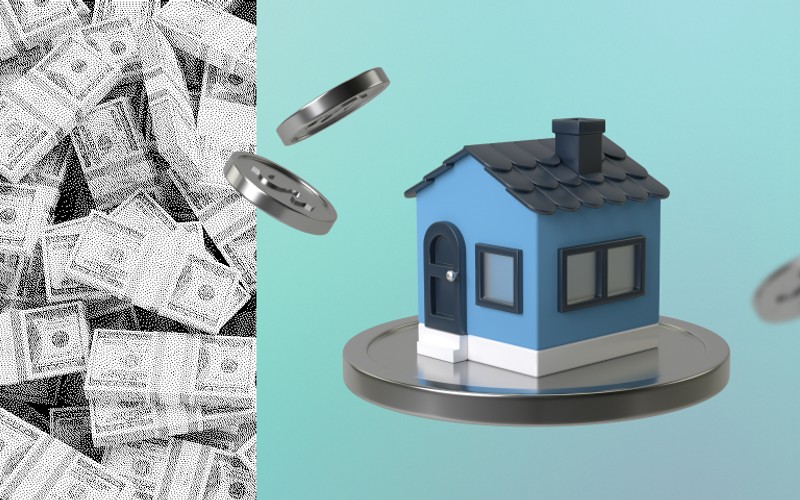While high-yield savings accounts and real estate investments offer opportunities to grow your money, they differ in terms of returns, timing, and tax implications.
Rates for high-yield savings accounts fluctuate and can offer a higher return rate than traditional savings. Real estate investments often offer consistent returns over time. That could mean that one occasionally outperforms the other.
You also need to consider the tax implications. Interest from high-yield savings accounts is taxed at your highest marginal tax rate. This can mean paying nearly 45% in taxes for high earners in high-tax states. In contrast, appreciation from real estate is taxed at capital gains rates, which are around 15% for most people. REIT dividends, which comprise at least 90% of taxable income, are typically taxed at ordinary income rates ranging from 10% to 37%, depending on your total income.
Markets Fluctuate
Real estate and earnings from high-yield savings accounts can fluctuate like any investment.
The economy is constantly evolving.
Take inflation, for example. In 2022, inflation often felt like a runaway train. The Federal Reserve responded with rate hikes to cool off inflation and stabilize the economy. On the one hand, that’s not great news, as rate hikes usually increase variable interest rates on financial products like credit cards. But on the other hand, a Fed rate hike can also increase APYs on vehicles like high-yield savings accounts—at least temporarily.
As of August 2024, high-yield savings accounts were earning as much as 5.00% APY (and higher in some cases). When APYs are high, it might make sense to stash your cash in a high-yield savings account, especially over a traditional savings account that may only earn a fraction of that.
But that’s the rub: Rates don’t stay high.
When you sign up for a high-yield savings account, you agree to a variable rate heavily tied to the current economy. In our example case, as inflation keeps cooling, APYs may go down.
On the other hand, real estate traditionally has lower volatility, meaning returns stay on pace year-over-year. This is especially true with fractional real estate like Arrived, where you can spread your investment over several properties in multiple markets.
Then There’s Tax Implications
When you make any investment, you’ll likely end up paying taxes. In the case of high-yield savings accounts, interest income is taxed at your highest marginal tax rate. That could be more than 30% federal income taxes on every dollar, plus the potential for additional state income tax.
Plus, if you’re a high earner and live in a high-tax state, you could end up paying nearly 45% tax on interest income.
Taxes can be more complicated with real estate, but there are additional benefits. For one, dividends from rental income can benefit from depreciation, so you can defer some of the tax owed. Beyond that, appreciation is taxed at long-term capital gains rate, which currently sits at 15% for most people, half (or less) than the rate for interest income from high-yield savings accounts.
Arrived’s single family residential investment rental portfolio, the Arrived Single Family Residential Fund, and the Arrived Private Credit Fund are held in real estate investment trusts (REITs). REITs are required to distribute at least 90% of their taxable income to shareholders in the form of dividends. These dividends are typically taxed at ordinary income tax rates, which can range from 10% to 37% depending on your total income.
The dividends from REITs are generally considered "qualified dividends" if the REIT meets certain criteria. Qualified dividends are taxed at the same rates as long-term capital gains, typically lower than ordinary income tax rates. However, most of the dividends distributed by REITs are usually non-qualified dividends.
In addition to a host of other tax advantages, REITs are considered pass-through entities. In short, that means they don’t pay a corporate income tax (i.e., double taxation), and investors get to keep more of their money. Qualified dividends from REITs may also be eligible for the 20% Qualified Business Income (QBI) deduction
So, Which Is Better?
When comparing the two vehicles, you may want to consider both. While a professional financial advisor can look at your situation individually and help you determine a plan to maximize your wealth, the general rule of thumb is to consider diversification. Or, to put it another way, don’t put all your eggs in one financial basket.
High-yield savings accounts are easy to open, offer nearly instant liquidity, and may outpace your traditional savings account on APY earnings. On the other hand, real estate typically provides stability and the potential for long-term gains (not to mention some appealing tax advantages).
By diversifying across several financial vehicles, you’re better positioned to mitigate some of the risks or downsides and maximize the benefits. However, remember that there is no one-size-fits-all approach when it comes to finance. Every financial situation is unique.







